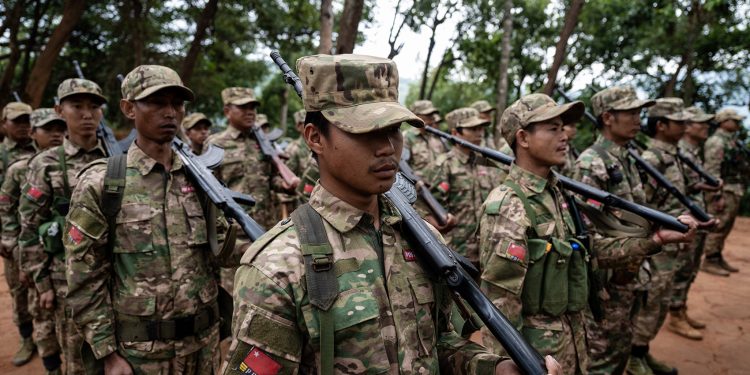It has often been noted that Myanmar’s revolution lacks a single high command and with it no grand strategy. This observation has frequently been used to argue that Myanmar’s revolution is unviable and the military cannot be defeated, with a negotiated settlement the only positive outcome.
Centralized instigation and control for Myanmar’s Spring Revolution were never necessary given it emerged as a bottom-up uprising driven by the population at large. New actors emerged and older ones helped carry it forward, but it’s always maintained an ethos of ‘collective leadership’ based on popular support that has proven effective.
Supporting this observation is the fact that nationwide armed resistance emerged at all, was sustained, has succeeded at inflicting historic defeats on an entrenched military, and builds ever greater momentum.
Over three years of armed resistance, much of what has transpired is, arguably, what would have happened if there had been a single resistance with a strong military and political strategy. There is widespread public support for revolution; resistance spans both the Bamar majority and most ethnic minority populations. The junta has lost control over much of Myanmar’s borders including the biggest crossings to China and Thailand. Some of the most heavily fortified parts of the country have been lost by the junta, namely northern Shan and Rakhine, thereby significantly degrading the military’s overall combat power. At the same time, resistance is strong across the Bamar heartland, meaning the junta must fight from the Indian Ocean all the way to the China border. Resistance reaches the doorsteps of Nay Pyi Taw and is also immediately outside of Mandalay city. It stretches from southern Shan and Karenni down to the tip of Tanintharyi. Junta aircraft are being downed regularly. Key infrastructure corridors in central parts of the country, such as the Yangon-Nay Pyi Taw highway, are under threat, while others, like the Asian Highway to the Thai border, have been lost by the junta. Military coordination between resistance groups is only increasing while shared political aspirations are becoming more explicit.
Myanmar’s revolution is driven forward by what can be termed an organic logic, which united a wide range of actors in a project to defeat Myanmar’s junta outright. This logic emerged through decades of ethnic insurgency upon which a coup sparked a multi-generational, cross-ethnic revolt from the bottom-up; all demanding a country free of military dictatorship and reformulated as a federal democracy.
What underpins this organic logic is twofold: the nature of the revolution as a popular national uprising and that the military’s progressive weaking provokes further escalation by the resistance. These intertwined dynamics – the organic nature of a bottom-up uprising and the logic of military successes begetting more action – are the foundation of Myanmar’s revolution.
What can be expected, because it is already happening, are rolling waves of collapse for a military spread too thin and bleeding in too many areas. What became obvious as the next step emerged through an unfolding of events that encouraged one action to follow another. A series of waves, the precise size and spread unknown but with a certain cadence and predictability. That Rakhine followed northern Shan and then Kachin and then Myawaddy was unsurprising. There was never going to be a single implosion of the junta, i.e., a tsunami. This is due to the dispersal of the resistance given its origins, the need to build trust between actors after years of national cleavages, and the sheer magnitude of trying to rid Myanmar of a military that held state power for decades and is willing to use mass violence. More pressing realities also prevented a single implosion. The first was the varied range of capacities inherent to assorted resistance forces. Related to this is the simple reality of ammunition, the currency of war. Either you have it or you don’t, and this affects the pace of everything.
Operation 1027 was certainly one of the waves and both a massive milestone and catalyst for the resistance, but it was not the first wave. It was also not an unpredictable ‘black swan’ event. Preceding it, and encouraging it to happen, were earlier waves. The first was the expansion and entrenchment of armed resistance across Sagaing and northern Magwe by the end of the 2022 dry season. That the junta had not succeeded in collapsing resistance in these Bamar heartland areas ensured they would continuously drain the junta of manpower and resources.
A second wave was the successes of the Karenni and Chin resistance forces over 2022. Though no towns were taken in either state, these resistance groups succeeded in saturating their states with resistance and thereby confining the junta increasingly to urban areas. A third wave was the offensive of the KNU and PDF allies along the Sittaung River starting in early 2023. This built upon concerted action over 2022 that had been taking back outposts lost by the KNU in earlier decades. These successes in Chin, Karenni and Kawthoolei demonstrated that the junta could not regain momentum in areas where it was losing freedom of movement and control over rural areas.
Myanmar’s revolution has a logic that has proven remarkably successful given the country’s context. It is certainly not as clear as would be wished, but it is there, nonetheless. Rolling waves of collapse are happening because of popular support for revolution and increasing clarity that the military is defeatable. The war’s trajectory is towards the junta’s outright defeat. But trajectories are merely that, a sense of direction and battlefield momentum. They can be stopped. Myanmar’s revolution faces threats from inside and outside. Ultimately more formalized relationships and structures will be needed. The organic logic that got it this far will have to morph further into more cogent relationships and institutions that thoroughly link revolutionary actors.
Matthew B. Arnold is an independent policy analyst. He has been researching Myanmar’s politics and governance since 2012.
















